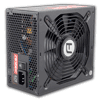Hi there, people.
Some days ago I asked about the low voltage my DeepCool Aurora 700W was providing on the +12v rail, got some answers, but sadly the PSU died a couple of days ago before I could start my project. The only thing I did was update my former i3 6100 for an i5 6500 a week ago. I ran Prime95 and other stuff to test the system stability and everything went just fine. I guess my PSU was doomed since day one...
Anyway, back where I live the prices are sky-high and I cannot buy online for several reasons, one of them being the prices, as they are still pretty high because of the taxes and tariffs.
Locally, there are only 5 good options I could find, and they cost about the same ($75 to $85):
EVGA 600W1 (80+ white), EVGA 650 N1 (no certification), Corsair CX 600 (80+ bronze), SeaSonic S12II 620W (80+ bronze), and the Thermaltake Smart 600W (80+ white). I found some info about the Seasonic and the Corsair, but almost nothing about the other three, especially when it comes to the real voltage levels they provide.
Which of those 5 could be considered the best, quality and value wise? I know these are 50W to 100W lower than my previous PSU, but that's fine with me. Any help will be greatly appreciated. Thanks!
Some days ago I asked about the low voltage my DeepCool Aurora 700W was providing on the +12v rail, got some answers, but sadly the PSU died a couple of days ago before I could start my project. The only thing I did was update my former i3 6100 for an i5 6500 a week ago. I ran Prime95 and other stuff to test the system stability and everything went just fine. I guess my PSU was doomed since day one...
Anyway, back where I live the prices are sky-high and I cannot buy online for several reasons, one of them being the prices, as they are still pretty high because of the taxes and tariffs.
Locally, there are only 5 good options I could find, and they cost about the same ($75 to $85):
EVGA 600W1 (80+ white), EVGA 650 N1 (no certification), Corsair CX 600 (80+ bronze), SeaSonic S12II 620W (80+ bronze), and the Thermaltake Smart 600W (80+ white). I found some info about the Seasonic and the Corsair, but almost nothing about the other three, especially when it comes to the real voltage levels they provide.
Which of those 5 could be considered the best, quality and value wise? I know these are 50W to 100W lower than my previous PSU, but that's fine with me. Any help will be greatly appreciated. Thanks!



